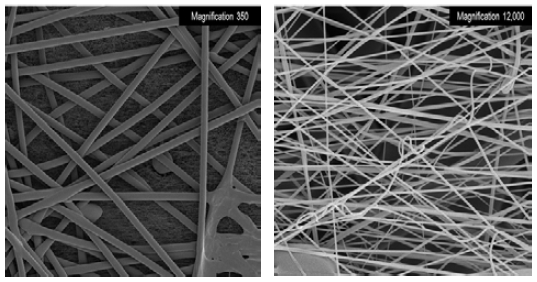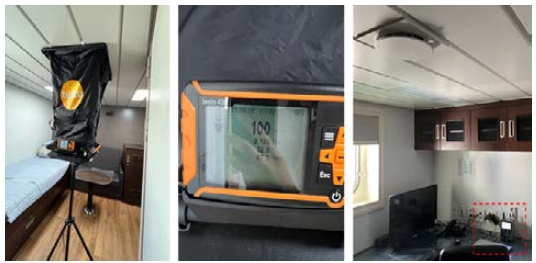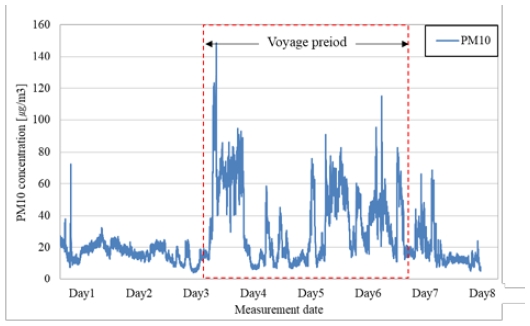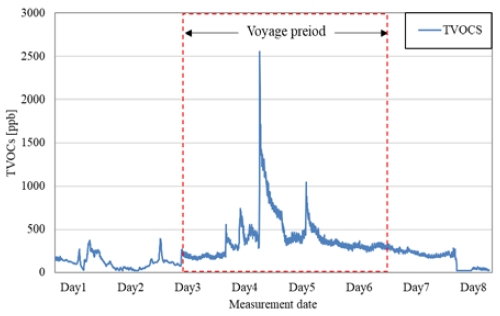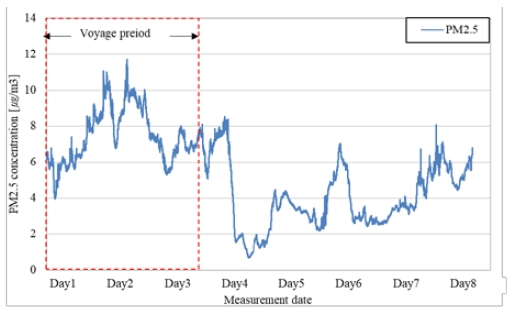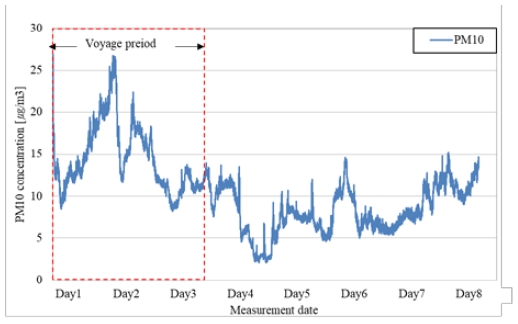
Development and empirical study on integrated ventilation–cleaning filter system for removal of harmful substances flowing into ship cabins
Copyright © The Korean Society of Marine Engineering
This is an Open Access article distributed under the terms of the Creative Commons Attribution Non-Commercial License (http://creativecommons.org/licenses/by-nc/3.0), which permits unrestricted non-commercial use, distribution, and reproduction in any medium, provided the original work is properly cited.
Abstract
Marine environment protection and the improvement of the internal environment of ships are emerging as necessary tasks in modern ship operations. In particular, soot and ash, which are harmful substances generated during fuel combustion in diesel engines, enter the interior of a ship, which degrades air quality inside the ship and adversely affects the health of crew members. Because ships are highly confidential compared to general buildings and it is difficult to achieve natural ventilation between the exterior and interior of a ship, various indoor air pollutants can spread rapidly into a ship if adequate ventilation or removal systems are lacking, thereby posing a risk to the respiratory health of passengers and crew members. In this study, a combined ventilation–cleaning filter system was developed to effectively filter out harmful substances and improve the air quality inside the cabin. DB, PM10, and PM2.5, which are harmful particulate substances, and total volatile organic compounds, which are harmful gaseous substances, were measured inside the cabin of a ship to determine its indoor air quality. The measurement results for the fine-particle size concentration showed that PM2.5 and PM10 exhibited a similar increasing and decreasing trend, with pollutant concentrations up to six times higher during departure than at anchoring. The values were higher than the daily limit recommended by the World Health Organization (PM2.5: 25 μg/m3; PM10: 50 μg/m3). Based on the concentrations of volatile organic compounds, the concentration at ship departure showed a similar trend to that of fine particles in the cabin (1659 ppb), which was approximately five times higher than the daily average (333 ppb) recommended by AWAIR. A filter system for ship environments was designed using a simulation tool to address this problem. The filter system consisted of a filter for removing particulate pollutants. By optimizing the system, the pollutants generated from ships and the performance degradation of the existing air-conditioning system were minimized. In addition, we analyzed the current status of gas pollutants inside ships to examine the use of activated carbon attachment filters in removing gaseous pollutants. After filter installation, the fine-particle concentration decreased to a maximum of 25.67 μg/m3 (PM10), indicating a reduction by 2.6 times, and the average air quality increased to 9.7 μg/m3 (PM10). A system that can remove particulate pollutants and gaseous pollutants simultaneously should be investigated in future studies.
Keywords:
Marine environmental protection, Harmful substances, Combined filter system, Air quality1. Introduction
Marine environmental protection and improvement of indoor air quality on ships have become critical challenges in modern ship operations. In particular, harmful substances (such as soot and ash) are generated from combusted fuels of diesel engines. These substances may enter the interior of a ship, which impairs indoor air quality and adversely affects the health of the crew [1]. In recent years, there has been a high level of societal interest in indoor air quality, with the advancement of mandatory ventilation system installations in apartments, buildings, and public transportation since 2008. However, ships represent complex spaces for living and working, combining accommodations, workspaces, leisure facilities, and commercial spaces. Because of their specialized maritime purposes, research and facilities related to indoor air quality on ships are lacking.
Ships have significantly higher confidentiality requirements than regular buildings, and natural ventilation between the interior and exterior of a ship is difficult to achieve. Consequently, various indoor air pollutants can rapidly spread within the ship without appropriate ventilation or removal processes, posing a threat to the respiratory health of passengers and crew members [2][3].
Therefore, research and development are required to enhance ventilation systems and improve the indoor air quality within ship cabins [4][5]. In this study, we aimed to improve indoor air quality by developing a multilayered filter material that satisfied the dust removal efficiency and pressure drop (permeability) in a trade-off relationship. This filter material comprises an adsorption filter that uses activated carbon to remove volatile organic compounds, a nanofilter to remove dust using physical forces, and an electrostatic filter. The goal is to effectively improve the air quality within ship cabins by developing a clean H13-grade filter that can remove more than 99.95% of ultrafine dust, soot, ash, and volatile organic compounds.
2. Development of Ventilation and Purification Combined Filter System for Ships
2.1 Design of Filters Using Simulation Tools
By using a simulation tool, the ship filter technology was designed based on the ratio of the diameter of the filter fiber to the porosity according to the distribution of the fiber to predict the performance of each filter material and the performance of various filter material combinations. Thus, the simulation tool was used to design and manufacture suitable filter materials for ships. In this study, the fiber diameter, thickness, and porosity of the filter media were set as the key design parameters, and a filter capable of maintaining dust collection efficiency under high-humidity conditions was designed. Numerical goals were set for dust collection efficiency and filter differential pressure to maintain high-efficiency dust collection and achieve excellent ventilation, and the filter media that satisfied these goals were selected and reflected in the product. Figure 1 depicts the aerosol filter collection mechanisms, comprising gravitational settling, interception, inertial collision, and Brownian diffusion.
The environment of a ship is highly prone to humid conditions; therefore, using conventional filters can result in a rapid decrease in the filter dust collection efficiency, rendering them ineffective. Consequently, a filter material that effectively removes dust based on physical principles was designed, striking a balance between the dust collection efficiency and pressure drop, both of which are tradeoff factors.
The formulas for calculating filter performance based on the aerosol filter dust collection mechanism are as follows [7].
| (1) |
| (2) |
| (3) |
| (4) |
| (5) |
Equation (1) is the fundamental formula for predicting the primary performance of the filter, and it is the total filtration efficiency equation. This equation is essential for reflecting the effects of various factors related to filter attachment mechanisms, such as gravitational settling, blocking, inertial collision, and diffusion. Equation (2) represents a situation in which the performance of a filter is influenced by gravitational settling. This scenario describes how intermediate-sized particles pass through the fibrous tissue while moving with the gas but eventually depart at a point where the gas flow acceleration is insufficient, causing the particles to settle on the fiber surface under their self-weight. Equation (3) expresses the performance of a filter owing to inertial collisions, in which large particles, because of their high inertial energy, fail to move with the gas but instead collide with the filter fiber surface, remaining within the vicinity. Equation (4) describes the performance of a filter based on Brownian diffusion, which explains the situation in which tiny particles do not flow with the gas, but instead collide or bond with molecules, undergo irregular motion, and eventually come in contact with the filter fiber surface where they are captured. Equation (5) expresses the performance of a filter owing to blocking, indicating cases in which intermediate-sized particles with relatively low inertia tend to follow the gas flow but are blocked within narrow spaces within the fiber structure.
2.2 Examination of Filter Materials Using Scanning Electron Microscopy (SEM)
A surface analysis of the filter media was conducted using an electron beam microscope to determine whether the fabric diameter, a significant design factor, was designed according to the target design value and to examine the surface characteristics of each filter medium. Figure 2 shows the SEM images of the developed filter material. The filter material was fabricated according to the design specifications.
2.3 Performance Verification by Testing by Certified Authentication Authority for Manufactured Filter Material
Pressure steel tests were conducted for the developed shipbuilding efficiency according to ASTM F3502 standards to evaluate the concentrated efficiency of the filter media. TSI 8130 was injected into the air flow with NaCl particles, with an average particle diameter of 0.3 μm, and the injection efficiency was determined after filtering.
After repeated evaluations of five prepared samples of the developed fabric, the dust collection efficiency at the EPA level was 99.567% for the filter fabric, and the pressure drop was 25.89 Pa. This ensured excellent ventilation performance and confirmed that the developed filter fabric is suitable for ships. TSI 8130 satisfies the requirements of filter media tester and performance evaluation certification for filter materials (Figure 3).
3. Experimental Apparatus and Method
DB, PM10, and PM2.5, which represented harmful particulate substances, were measured inside the cabin and gymnasium of a ship to assess the indoor air quality of the ship. VOCs, which represented harmful gaseous substances, were measured for five months, and approximately 100,000 DBs were secured.
The ship used for demonstration had a total tonnage of 9,196 tons, 39 crew members, and 200 practice crew members. The ship contained various convenience facilities, such as a lecture room, crew cabin, and physical training room.
The ventilation air volume was measured using an air volume meter to observe variations in internal air quality after filter installation. The measurements were conducted by adopting a cabin where crew members usually stay among the various spaces in the ship. The same air volume was measured before and after installing the filter under the same conditions. No deterioration was observed regarding the performance of the heating, ventilation, and air conditioning system of the ship. The air volume meter was TESTO 420, with a range of 50–4000 m³/h and accuracy of 12 m³/h (at 22 °C). Three sets of measurement were performed.
Air quality was measured using an AWAIR Omni instrument, and fine dust was measured using Particle Counter 7301. Figure 4 shows photographs of data collection using the measuring instruments.
4. Results and Discussion
4.1 Measurement of PM2.5 and PM10 Concentrations During Ship Arrival and Departure
Figures 5 and 6 show the measurement results of particulate matter (PM) concentrations by size for PM2.5 and PM10, respectively. A similar trend was observed for PM2.5 and PM10. Pollution levels during ship departures increased significantly compared to when the ships were docked, reaching levels up to six times higher than the daily recommended standards of the World Health Organization (WHO, standards for PM concentration – PM2.5: 25 μg/m³; PM10: 50 μg/m³). This increase is attributed to the increase in fine PM precursor substances generated during fuel combustion in the engine room during departure.
The ratio of PM10 to PM2.5 concentrations in ambient air quality was approximately 1.78 times higher in Seoul (based on data from the Korea Environmental Corporation in 2022) and approximately 1.86 times higher according to a previous study (Zhou, 2016). In the maritime environment, when averaged over the entire database, this ratio appeared to be significantly higher by 3.8 times. This suggests that substances, such as soot, generated during fuel combustion in the engine room of a ship, are transported into the air after coagulation and growth.
Given the high ratio of PM10 to PM2.5 concentrations in ship emissions, the development of ventilation and purification filters for marine vessels can be categorized into products with varying levels of filtration efficiency based on system performance. This may include filters rated at 99.97% efficiency or higher, equivalent to the HEPA grade (for example, H13 and H14), and filters rated below 99.97% efficiency, such as the EPA grade (for example, E12 and E11), depending on the system load.
4.2 Measurement of Total Volatile Organic Compounds Concentrations at Ports of Entry and Exit
The measurement results of total volatile organic compound concentrations in the indoor gymnasium located on the ship showed a similar trend to that of the fine particle concentration in the cabin, with high concentrations observed during departure. The concentration exceeded approximately five times the daily recommended limit of 333 ppb by Awair, reaching 1659 ppb. This suggests that an unhealthy indoor environment may cause symptoms for the crew, such as dizziness, headache, nausea, and respiratory discomfort.
During mooring, an increase in the concentration of volatile organic compounds was observed, attributed to the activities of the crew (such as cooking) and engine testing. Exhaust gases generated by the engine were introduced into the ventilation system of the ship, which resulted in this increase. This demonstrates the need for an odor-filtering system that utilizes activated carbon to remove volatile organic chemicals in future research. Figure 7 shows the measured volatile organic compound concentrations in the vessel.
4.3 Measurement of Harmful Substance Concentrations After Installation of Ship Ventilation and Purification Combined Filter System
Existing ventilation filters from the relevant authority were installed on the ships to analyze the decrease in indoor fine PM concentration on ships owing to the installation of clean ventilation filters. Air quality databases have been created and analyzed for environments characterized by high concentrations of harmful substances, high humidity, and strong winds.
The measurement results of the PM concentration revealed that filter installation yielded a maximum decrease of 25.67 μg/m3 (PM10), which is 2.6 times lower than the maximum value before filter installation. The average measured PM10 concentration was 9.7 μg/m3, indicating an improvement in air quality. During departure and while docked, the indoor fine PM concentrations on the ships were below the values recommended by WHO (WHO standards for PM concentration - PM2.5: 25 μg/m3; PM10: 50 μg/m3), confirming an improvement in indoor air quality. Figures 8 and 9 show the indoor air quality measurement results of the ship after the installation of filters for fine particles (PM2.5 and PM10, respectively).
4. Conclusion
Ships have a significantly higher level of confidentiality than conventional buildings, and natural ventilation between the interior and exterior of a ship is difficult to achieve. Therefore, various indoor air pollutants can spread rapidly within a ship without appropriate ventilation and removal processes, posing a threat to the respiratory health of passengers and crew members.
Research and development to improve ship ventilation systems and enhance the indoor air quality within ship cabins are urgently required. Based on the development of a combined ventilation–cleaning filter system and the measurement of fine dust and volatile organic-compound concentrations before and after installation, the following conclusions are drawn.
- 1. The measurement results of pollutant concentrations by particle size showed a similar trend between PM2.5 and PM10, with the pollution levels increasing and decreasing accordingly. Pollutant concentrations were up to six times higher during ship departure than after ship anchoring. The obtained values generally exceeded WHO’s daily recommended standards for PM concentrations (WHO standards for particulate matter concentration - PM2.5: 25 μg/m3; PM10: 50 μg/m3).
- 2. The volatile organic-compound concentrations in the gymnasium in the ship showed a trend similar to that of the fine particle concentration in the cabin, with a high concentration obtained during departure. The concentration exceeded the daily average recommended by the AWAIR company by approximately five times, reaching 1659 ppb, compared with the recommended value of 333 ppb. This indicates an unhealthy indoor environment that can cause symptoms, such as dizziness, headaches, nausea, and respiratory discomfort.
- 3. During anchorage, an increase in the concentration of volatile organic compounds was observed, owing to the activities of the crew (such as cooking) and engine testing. The exhaust gases generated by the engine were introduced into the ventilation system of the ship and subsequently circulated.
- 4. After filter installation, the concentration of fine particles by size showed a maximum decrease of up to 25.67 μg/m3 (PM10) compared to the maximum value before filter installation. The average value was 9.7 μg/m3 (PM10), indicating an improvement in air quality. During departure and while anchored, the indoor fine-particle concentration on the ship was lower than the recommended standards of WHO (WHO standard fine-particle concentration criteria - PM2.5: 25 μg/m3; PM10: 50 μg/m3).
- 5. Because ship environments are highly susceptible to high-humidity conditions, the use of conventional filters can lead to a rapid decrease in filter dust collection efficiency over a short period, rendering them ineffective. Therefore, it is necessary to use filter materials that apply physical forces in removing dust by combining them, satisfying the trade-off relationship between dust collection efficiency and pressure drop and improving filter performance.
Acknowledgments
This work was supported by the Technology development Program (00221800) funded by the Ministry of SMEs and Startups (MSS, Korea).
Author Contributions
Conceptualization, H. Y. Ko and S. D. Lee; Methodology, H. Y. Ko; Software, H. Y. Ko; Validation, H. Y. Ko and S. D. Lee; Formal Analysis, H. Y. Ko; Investigation, H. Y. Ko; Resources, H.Y. Ko; Data Curation, J. H. Lee, S. A. Lee and J. K. Kang; Writing—Original Draft Preparation, S. A. Lee; Writing—Review & Editing S. D. Lee; Visualization, S. A. Lee; Supervision, S. D. Lee; Project Administration, S. D. Lee; Funding Acquisition, S. D. Lee.
References
- N. S. Kwak, S. H. Park, T. K. Kim, and J. S. Park. “A research on the measurement and analysis of indoor air quality for 2,996-ton ships,” Proceedings of the KSMPE Autumn Conference 2022, 2007 (in Korean).
-
K. I. Hwang, “A prediction on indoor contaminant diffusioon charateristics of a training ship by mechanical ventilation system,” Journal of the Korean Society of Marine Engineering, vol. 35, no. 8, pp. 1124-1131, 2011 (in Korean).
[https://doi.org/10.5916/jkosme.2011.35.8.1124]

-
G. Y. Doe, H. S. Lee, Y. G. Lee, and H. K. Lee, “A study on indoor air quality in new ship,” Journal of Korea Navigation and Port Research, vol. 31, no. 5, pp. 427-434, 2007 (in Korean).
[https://doi.org/10.5394/KINPR.2007.31.5.427]

- S. S. Kim, “The importance and current status on indoor air quality on ships,” Korea Air Cleaning Association, vol. 27, no. 3, 2014.
- J. H. Jang, S. B. Oh, Y. H. Yang, and H. J. Kim, “Consideration of physical environment in ship traffic management,” The Korean Association of Maritime Police Science, vol. 6, no. 12, pp. 143-162, 2016.
- W. C. Hinds, Aerosol Technology: Properties, Behavior, and Measurement of Airborne Particles, 2nd Edition: John Wiley & Sons Inc., New York, USA, 1999.
-
B. T. H. Borgelink, A. E. Carchia, J. F. Hernández-Sánchez, D. Caputo, J. G .E. Gardeniers, and A. Susarrey-Arce, “Filtering efficiency model that includes the statistical randomness of non-woven fiber layers in facemasks,” Separation and Purification Technology, vol. 282, Part A, 2022.
[https://doi.org/10.1016/j.seppur.2021.120049]



